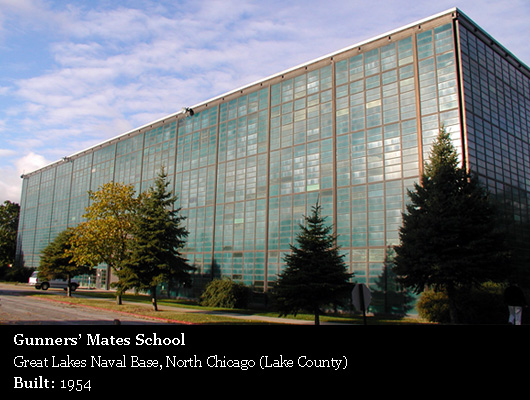The demise of Building 521
By Robin Amer

The demise of Building 521
By Robin Amer
It’s Navy Week in Chicago, and here at Navy Pier we’ve been listening to the Blue Angels zoom past overhead all day, practicing for this weekend’s Air and Water Show. To mark the event, we’re going to take a jaunt 40-miles north of Chicago to revisit a modernist building tied to the region’s naval – and architectural – history.
Naval Station Great Lakes in Great Lakes, Ill., provides technical training to 37,000 recruits every year, according to the naval station’s web site. And starting in 1954, Building 521 housed a significant portion of recruits training. Also known as the Gunner’s Mate School, Building 521 was designed to house a full-scale artillery set-up, the kind that could mimic warfare aboard a destroyer.

. . .the 1954 Gunner’s Mate School was straight out of the master’s Bauhaus book – square in plan, with a handsomely proportioned exterior that enclosed the kind of sprawling, column-free interiors that would later appear in convention centers. “Universal space,” Mies called such interiors because they were meant to adapt to different functions over time. Into the building’s spaces, roughly 55 feet tall, the Navy plugged towering ship mock-ups, painted battleship gray, and outfitted them with stairways, decks, gunnery and overhead cranes to shift the weaponry around. At the core was a concrete-walled structure that housed classrooms for the sailors, essentially a building within a building.
But in 2005 the Navy made plans to demolish Building 521, along with another Skidmore building elsewhere on the site; computers, the Navy said, had made its older training equipment obsolete. And, if they didn’t tear down the building right away, they feared they might be penalized under a Department of Defense policy that withholds money for building maintenance when too many existing buildings stand empty.
Several preservation groups, including Landmark Illinois, stepped in to see if it was possible to rehab Building 521, or at least “moth ball” it – leave it alone until the Navy could figure out a future use. Landmark Illinois put the Gunner’s Mate School on its 2008 list of most endangered buildings, and Skidmore, Owings & Merrill developed several potential reuse plans pro-bono. The Tribune’s Kamin wrote an impassioned plea for preserving the building called “Why the Navy should act to save this ‘box’” in which he described Building 521 as a “cathedral of the Cold War”:
What is at risk is a precious, heretofore little-known, chapter in the story of the Second Chicago School of Architecture, that flowering of power modernism that produced such much-admired landmarks as the Inland Steel Building and the Hancock Center…
None of their efforts bore fruit. The Navy rejected the preservationists’ proposal, and Building 521 was demolished in the spring of 2009.
So how did the firm behind some of Chicago’s most legendary sky-scrapers get into business with the Navy in the first place? Landmarks Illinois’ Lisa DiChiera explains the evolution of that peculiar relationship in the audio above. It starts with an army town in Tennessee and ends – at least for our purposes – north of Chicago.
Dynamic Range showcases hidden gems unearthed from Chicago Amplified’s vast archive of public events and appears on weekends. Lisa DiChiera spoke at an event presented by Chicago Architecture Foundation in December 2008. Click here to hear the event in its entirety.
